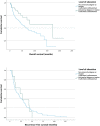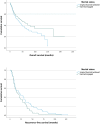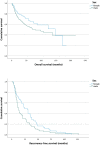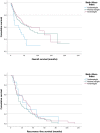Socioeconomic disparities between oral cavity cancer patients in Germany
- PMID: 35937274
- PMCID: PMC9353687
- DOI: 10.3389/fpubh.2022.831479
Socioeconomic disparities between oral cavity cancer patients in Germany
Abstract
Objective: In many countries the access to high quality medical service depends on socioeconomic factors. Therefore, these factors are associated with the treatment and prognosis of many diseases. In Germany health care is claimed to be independent from such factors due to obligatory health insurance and a well-developed medical infrastructure. Thus, socioeconomically caused health disparities should be absent. The aim of this study was to analyze the association between socioeconomic factors and the survival of oral cavity cancer in Germany.
Patients and methods: In this descriptive cohort study socioeconomic status related factors as well as demographic, tumor-specific, and comorbidity factors of 500 patients treated for oral cavity cancer were obtained in the university hospital of Dresden. Pearson correlation was used to describe associations between continuous variables. Associations between categorical variables were assessed using the chi-square test. Overall and recurrence-free survival were studied using the Kaplan-Meier method. Log-rank test was carried out to test between-group differences. Cox proportional hazard models were used to estimate the risk of death and the risk of recurrence.
Results: Significant differences in overall survival were found between the different educational levels and sex. Seventy-nine percent of the patients did not have a university degree or master craftsman/craftswoman. Less discrepancy was observed according to the marital status (49.4% married/engaged vs. 47.8% single, divorced, or widowed). In the multivariable analysis only sex, age at diagnosis, the Charlson score, the number of positive lymph nodes, and the nodal status were identified as independent predictors for overall survival whereas sex and the age at diagnosis were identified as independent predictors for recurrence-free survival.
Conclusion: Despite the equitable health system in Germany, significant associations between overall survival of oral cavity cancer and different socioeconomic factors could be found. For elimination of these disparities, health education programs should be established in socially deprived areas. Furthermore, clinicians should keep these factors in mind when determining recall periods for dental check-ups.
Keywords: Germany; OSCC; epidemiology; level of education; oral cancer; oral squamous cell carcinoma; socioeconomic factors; survival.
Copyright © 2022 Muallah, Matschke, Muallah, Klimova, Kroschwald, Schröder, Lauer and Haim.
Figures




Similar articles
-
Race, not socioeconomic disparities, correlates with survival in human papillomavirus-negative oropharyngeal cancer: A retrospective study.Am J Otolaryngol. 2021 Jan-Feb;42(1):102816. doi: 10.1016/j.amjoto.2020.102816. Epub 2020 Oct 28. Am J Otolaryngol. 2021. PMID: 33161259
-
Beyond Science: Effect of Marital Status and Socioeconomic Index on Outcomes of Spinal Cord Tumors: Analysis From a National Cancer Registry.World Neurosurg. 2019 Jan;121:e333-e343. doi: 10.1016/j.wneu.2018.09.103. Epub 2018 Sep 24. World Neurosurg. 2019. PMID: 30261382
-
Effect of marital status on survival in glioblastoma multiforme by demographics, education, economic factors, and insurance status.Cancer Med. 2018 Aug;7(8):3722-3742. doi: 10.1002/cam4.1688. Epub 2018 Jul 15. Cancer Med. 2018. PMID: 30009575 Free PMC article.
-
Overexpression of cysteine-glutamate transporter and CD44 for prediction of recurrence and survival in patients with oral cavity squamous cell carcinoma.Head Neck. 2018 Nov;40(11):2340-2346. doi: 10.1002/hed.25331. Epub 2018 Oct 10. Head Neck. 2018. PMID: 30303590
-
Socioeconomic influence on treatment and outcome of patients with oral cancer in Germany.Oral Maxillofac Surg. 2022 Sep;26(3):365-371. doi: 10.1007/s10006-021-00997-1. Epub 2021 Aug 26. Oral Maxillofac Surg. 2022. PMID: 34436719 Free PMC article.
Cited by
-
Socioeconomic disparities: a more important risk factor for advanced-stage oral cancer in Florida than smoking?Cancer Causes Control. 2025 Mar 29. doi: 10.1007/s10552-025-01992-7. Online ahead of print. Cancer Causes Control. 2025. PMID: 40158041
-
Beyond Genetics: Exploring Lifestyle, Microbiome, and Social Determinants in Oral Cancer Development.Cancers (Basel). 2025 Mar 25;17(7):1094. doi: 10.3390/cancers17071094. Cancers (Basel). 2025. PMID: 40227635 Free PMC article. Review.
-
The duration of intervals on the oral cancer care pathway and implications for survival: a systematic review and meta-analysis.Front Public Health. 2023 Aug 8;11:1183244. doi: 10.3389/fpubh.2023.1183244. eCollection 2023. Front Public Health. 2023. PMID: 37614446 Free PMC article.
References
-
- Wienecke A, Kraywinkel K. Epidemiologie von Kopf-Hals-Tumoren in Deutschland. Der Onkol. (2019) 25:190–200. 10.1007/s00761-019-0534-0 - DOI
MeSH terms
LinkOut - more resources
Full Text Sources
Medical

